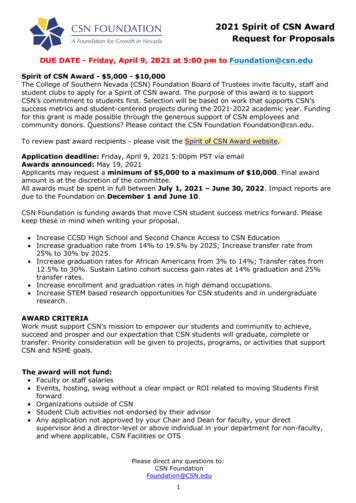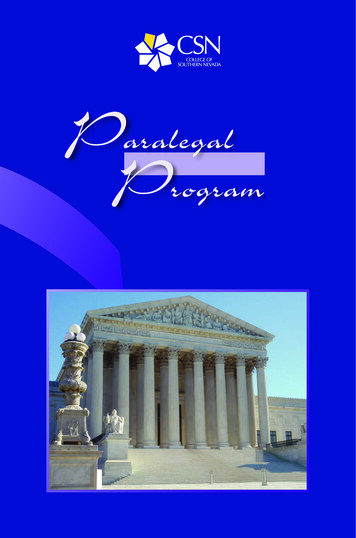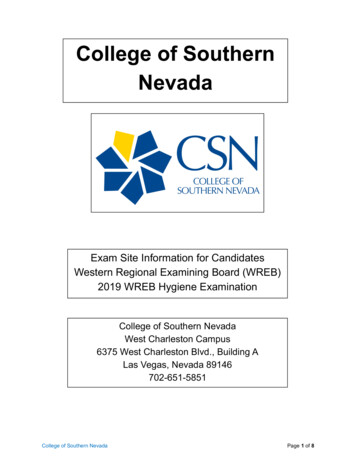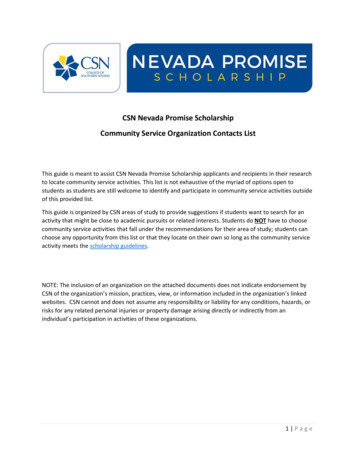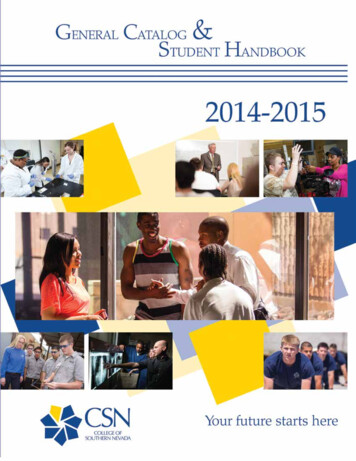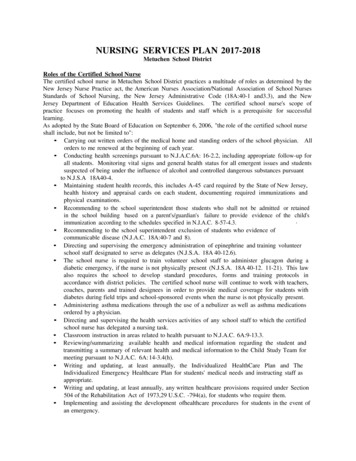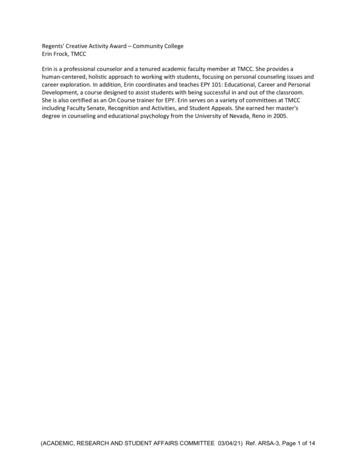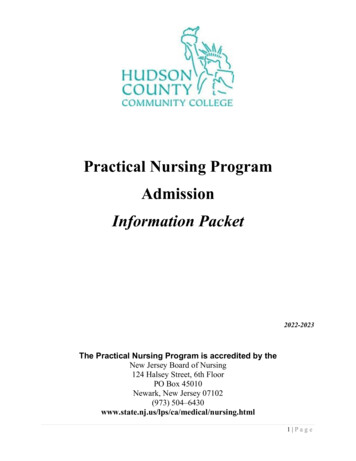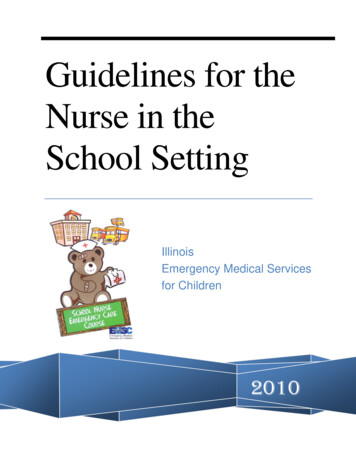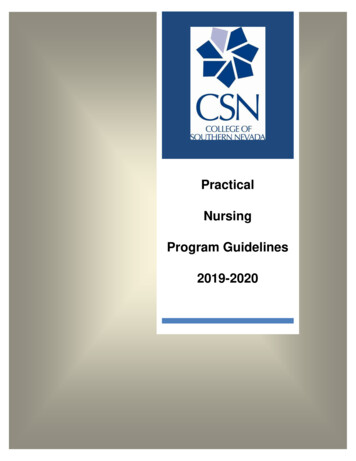
Transcription
Practical NursingPrograPracticalNursingProgram Guidelines 2017-2018m Guidelines 2017-201PracticalNursingProgram Guidelines2019-2020[Type text]Page 1
Table of ContentsAccreditation/Approval Status of the PN Program.4Handbook Disclaimer.4Mission Statement.5Core Values .5General Information .6Curriculum – Practical Nursing Program .6Curriculum – Military Medic/Corpsman to LPN .7Philosophy .8Organizing Framework 9Organizing Framework Diagram 10Practical Nursing Student Learning Outcomes.11Practical Nursing Program Outcomes .12Auditing a Course.13Transfer Students .13Professional Standards .14Code for Licensed Practical/Vocational Nurses .15NSNA Code of Academic and Clinical Conduct .16Honor Code . .17Academic Honesty.17Disability Resources .17Electronic Device .18Students as Committee Members.19Communications to Students .19Mandatory Advising.19Missed Appointments .20Health Documents . 20Name Change.21Academic Policies . 21Progression in the Practical Nursing Program . 21To Remain in Good Academic Standing . 22Grades . . 22Credit Class Instructional Ratio . 22Content Mastery Testing . 23Learning Contracts . .23Unsatisfactory Progress Notification . . 23Practical Nursing Program GuidelinesPage2
Attendance and Preparedness .24Information on Absences from Exams, Lab, or Clinical Practicum. 24Information on Tardiness to Exams, Lab, or Clinical Practicum . 26Information on Being Unprepared. 27Information on Referral to the Nursing Academic Progression and Graduation Committee(APG).28Faculty Absences . 30Course Withdrawal and/or Failure . 30Reinstatement to a Nursing Program . 30Readmission to Program. .31Medication Dosage Calculation Policy. 31Clinical Policies. 32Uniform and Dress Code. 34Required Equipment . 35Clinical Assignment .35Confidentiality of Patient’s Records . 35Leveled Clinical Skills Notebook. 35Clinical Performance . 36Clinical Evaluations . 36Critical Incident . 37Critical Elements . 37Tips for Success . 38Student-to-Student Tips for Success . 39Appendices .41Nursing Documentation Guidelines 42CSN Policy School of Health Sciences Reinstatement 44Student Learning Contract: Theory . 47Student Learning Contract: Clinical/Lab . 49Lab Tardy . 51Clinical Tardy . 52Lab/Clinical Unpreparedness . 53Lab/Clinical/Exam Absence . 54Recommendation for Removal from a Health Sciences Program .55Name Change Form. 56Practical Nursing Program Graduate Reference . 57Equal Opportunity is the Law . 60Revised 8/13/2015; 8/10/2019Edited 7/18/2016; 6/20/2017; 9/2017Practical Nursing Program GuidelinesPage3
Accreditation/Approval Status of the Practical NursingProgramThe Practical Nursing programs are designed to prepare the graduate to providenursing care in structured health care settings for clients of all ages who have welldefined health problems with predictable outcomes. Graduates are eligible to apply totake the NCLEX-PN exam for state licensure and become a licensed practical nurse(LPN). The Practical Nursing programs have full approval status by the Nevada StateBoard of Nursing, 4220 S Maryland Pkwy, Suite 300, Las Vegas, NV, 89119, (702)486-5800 and are accredited by the Accreditation Commission for Education inNursing, Inc., 3343 Peachtree Rd. N.E., Suite 850, Atlanta, GA 30326, (404) 9755000.HANDBOOK DISCLAIMER:PLEASE NOTE THAT THE NURSING PROGRAM GUIDELINES FOR THE CURRENTACADEMIC YEAR WILL BE FOLLOWED. PAST EDITIONS OF THE GUIDELINES WILLNOT BE UTILIZED FOR ANY PURPOSES.Practical Nursing Program GuidelinesPage4
Mission StatementThe CSN Nursing Department’s mission is to graduate competent, compassionate, caringnurses and nursing assistants who strive for excellence in their delivery of care to adiverse community. The department supports academic success through studentengagement, cultural and scientific literacy, and assisting students to meet theireducational and professional goals.Adopted Fall 2002: Revised Fall, 2007; Fall 2009; Fall 2014; Spring 2017The mission of the Practical Nursing Program is to provide an inclusive learning environmentusing a variety of delivery methods to a diverse population. The goal is to promote studentsuccess and prepare graduates who practice safe, entry level practical nursing care.Adopted Spring 2016: Revised Fall, 2018Core ValuesCaringProvide an environment of kindness and compassion that recognizes and supports culturalsensitivity.CommunicationCreate an environment that supports shared decision-making, cohesiveness,collaboration, and teamwork through active listening.CompetenceA shared commitment to provide a safe environment that strives for excellence, highexpectations, productivity, nursing knowledge/academic excellence, and is goal-orientated.CreativityUse critical thinking to explore innovative ways to positively impact nursing care.ProfessionalismAn environment that is mutually responsive to lifelong learning, collegiality, accountability,and patient advocacy.Practical Nursing Program GuidelinesPage5
General InformationCurriculum – Practical Nursing Program: No Prerequisite TractFirst Semester Courses (Summer)HHP 123BIntro to the Human BodyHHP 124BIntro to the Human Body Computer LabENGLISHEnglish 100, 101, 102, 113, or 114MATH 120 orCollege Mathabove*except Math 122 & Math 123Credits413-5 cr3TOTAL 11-13Second Semester Courses (Fall)PN 103BGerontological Health CarePN 104BFundamentals of Practical NursingPN 105BPractical Nursing IPN 125BPharmacology for Practical NursingCredits2552TOTAL 14Third Semester Courses (Spring)PN 106BFamily NursingPN 108BPractical Nursing IIPN 110BPractical Nursing Preceptorship/ProfessionalismCredits344TOTAL 11TOTAL PROGRAM CREDITS 36-38 All courses require a C or better to continue in the program.Practical Nursing Program GuidelinesPage6
Curriculum – Military Medic/Corpsman to LPN Track (Designed to bridgemilitary education and experience with the Nevada LPN)Program Prerequisites:CoursesCreditsMilitary Medical Courses16ENG 101 Composition 13TOTAL 19Fall SemesterCreditsPN 106BFamily Nursing3PN 107BAdult Health Nursing I4.5Spring SemesterCreditsPN 109BAdult Health Nursing II4.5PN 111BPractical Nursing Leadership/Management3TOTAL 15TOTAL PROGRAM CREDITS 34 All courses require a C or better to continue in the program.Practical Nursing Program GuidelinesPage 7
Practical Nursing ProgramPhilosophyThe Practical Nursing Program believes that Practical Nursing (PN) is based in the biological,psychological, social, and spiritual sciences. Licensed Practical Nurses (LPNs) care for diverseindividuals and families in a variety of inpatient and community-based settings by providing safe,culturally sensitive, individualized patient centered care as a member of the health care team.Nursing is a profession that contributes to the health and well-being of the individual. As providers ofcare, LPNs contribute to the promotion of wellness, use nursing judgment in the identification ofcurrent and emerging patient problems, and function as advocates for individuals and families. LPNsdemonstrate leadership by guiding and directing other LPNs and unlicensed assistive personnel toprovide safe, quality patient care within the state’s scope of practice. LPNs provide selected patienteducation and reinforce education provided by other members of the health care team to achievepositive clinical outcomes.Professional values guide interactions with individuals, families, and the health care team. LPNsdemonstrate professional behaviors by exhibiting accountability for ones actions, meeting the healthcare needs of patients, and assuming legal responsibility for the care provided. LPNs demonstrateprofessional identity by upholding a commitment to the public and by adhering to an established codeof ethics.LPNs recognize that teamwork and interprofessional collaboration among health care professionals iscritical for delivering safe, quality patient care. The LPN is an integral part of the nursing team anduses knowledge and skills to meet the basic health needs for clients with stable, well-defined healthcare needs in a variety of settings under the direction of qualified health professionals. In complexsituations, the practical nurse communicates significant observations to the registered nurse and/orphysician for guidance in meeting specific nursing requirements. Implementing established evidence–based care is essential to the delivery of quality, safe, patient-centered care.The faculty believes the teaching-learning process is a cooperative and collaborative effort between thestudent and the teacher and that the adult learner desires relevancy in the curriculum. The educationalprocess includes clearly defined goals and conducted in a positive learning environment where thelearner is considered as having inherent worth, uniqueness, and individual learning needs. The facultyrecognizes that students learn at different rates, from simple to complex, possess varying learningstyles, and therefore, strive to accommodate these individualized differences through curriculumplanning and teaching strategies. The teacher is regarded as a facilitator of learning.Approved 12/10/1999Reviewed and approved 11/12/2004Reviewed 10/2009Revised 8/2018Practical Nursing Program GuidelinesPage 8
Organizing FrameworkUsing the philosophy as a foundation, the CSN faculty of nursing developed an organizingframework for the Practical Nursing (PN) curriculum. The organizing framework uses the keycurricular concepts of application of knowledge, development of critical thinking, caring,communication, professionalism, teaching/learning, and collaboration. The key curricularconcepts include the behaviors of practicing within a regulatory framework, ethical standards,valuing a nursing career, and commitment to professional growth, continuous learning, andself-development.The concept of adaptation focuses on each individual as being unique and viewed asbiological, psychological, social, cultural, and spiritual beings that interact with and adapt totheir changing internal and external environment. Each individual has unique capabilities,characteristics, values, experiences; physical emotional, social, and spiritual needs; valuesystems, and live experiences that influence adaptive behaviors. Adaptation is a dynamicprocess because the individual’s environment is continually changing. An individual’s responseto environmental change results in adaptive or maladaptive responses. Adaptive responses arecoping mechanisms that promote health, growth, and quality of life or death with dignity. A goalof nursing is to promote adaptation. Encouraging adaptation assists individuals and theirfamilies to maintain or achieve health, growth, and quality of life or death with dignity.The CSN PN nursing graduate interacts with patients using the concepts of application ofknowledge, critical thinking, caring, communication, professionalism, teaching/learning, andcollaboration to assist patients to adapt to their changing internal and external environmentswith the goal of promoting health, growth, and quality of life or death with dignity. This isillustrated in the Organizing Framework Diagram on the next page.ReferencesAmerican Nurses Association. (2016).What is Nursing? Retrieved hat-Is-NursingApproved 4/16/2004Re-approved 10/2009Revised 3/2017Approved 5/2017Reviewed 2/2018, 8/2018Practical Nursing Program GuidelinesPage 9
Organizing Framework DiagramRevised 3/2017Approved 5/2017Reviewed 2/2018Practical Nursing Program GuidelinesPage 10
Practical Nursing Program Student Learning OutcomesUpon graduation from the CSN Practical Nursing Program, the graduate will be able to:1. Provide safe, quality, evidence-based, patient-centered nursing care to restore,promote, and maintain physical and mental health throughout the lifespan in a variety ofhealthcare settings.2. Participate in clinical judgement to make patient–centered care decisions supported bythe best current evidence.3. Participate in quality improvement processes to continuously improve the quality andsafety of health care systems and its practice.4. Participate in collaboration and teamwork with the interdisciplinary team, the patient,and the patient’s support persons to enhance patient satisfaction, health outcomes, andshared decision-making.5. Demonstrate accountability and responsibility for one’s own nursing practice consistentwith established legal, ethical, and professional standards.6. Use information and technology to communicate, manage knowledge, avoid error, andsupport decision-making.Approved 12/2/2002Reviewed and approved 11/12/2004Revised 7/2015, 8/2018Practical Nursing Program GuidelinesPage 11
Practical Nursing Program OutcomesPerformance on End-of-Program Student Learning Outcomes100% of the Practical Nursing graduates will attain at least a 2 rating on the final clinicalevaluation tool (PN 110B).100% of the Military Medic/Corpsman to LPN graduates will attain at least a 2 rating on allthree clinical evaluation tools (PN 106B, PN 107B, and PN 109B).Performance on Licensure ExamsAnnually, the Practical Nursing and Military Medic/Corpsman to LPN graduates will meet orexceed 80% on the NCLEX-PN licensure exam as first-time test takers.Program CompletionAt least 70% of the students who enter the Practical Nursing Program will graduate in nomore than five (5) semesters or 150% of the nursing program length, beginning withenrollment in the first nursing course.At least 80% of the students who enter the Military Medic/Corpsman to LPN Program willgraduate in two (2) semesters.Program Satisfaction (End-of-Program Survey)95% of the Practical Nursing and Military Medic/Corpsman to LPN graduates will rate thequality of curriculum, classroom, and clinical use in attaining program outcomes an averageof a 3.0 or higher on a 5-point Likert scale.Job PlacementWithin six to twelve months after graduation, at least 75% of the Practical Nursing andMilitary Medic/Corpsman to LPN graduates who desire employment will be employed in thefield of nursing.Approved 4/16/04Reviewed 10/2009Revised 7/13/2016; 6/27/17;9/17/2017Practical Nursing Program GuidelinesPage 12
Auditing a CourseA nursing student cannot audit a required nursing course. Exceptions include, but are notlimited to, students wanting to audit a course that was previously completed or nursesrequesting to audit for professional reasons. Requests to audit a nursing course must beinitiated with the PN Program Director who will consult with the course coordinator. Audit isdependent upon faculty approval, space availability, existing college policies, andprofessional regulations. Students who are auditing a course will be required to follow thesame program policies as non-auditing students.Disclaimer: Changes to published nursing course schedules may be necessary dueto unforeseen or uncontrollable circumstances within the nursing program or clinicalagencies. CSN Nursing Department administration reserves the right to cancelsections, change days, dates, times, and locations of nursing course sections at anytime. Such changes may affect previously assigned student course and sectionselections. Students will be informed by email or phone message and will be requiredto change their schedules accordingly.Transfer StudentsAn applicant seeking recognition of previously earned nursing credits at another college oruniversity nursing program must meet all requirements for admission including thepreadmission exam for the nursing program, all immunizations, and a completed healthhistory and physical. In addition, the applicant must submit: Course syllabi containing course outline(s) and course objective(s) for all earnednursing credits which are to be evaluated. A letter of recommendation from the Dean/Director of the nursing programpreviously attended.Upon receipt, the PN Program Director and appropriate faculty will review all materials todetermine which, if any, credits will be considered transferable. Transferability isconsidered in terms of similarity in course content, course grades, course credits, andcourse sequence. Nursing course grades must be “C” or higher to be considered fortransfer.After this review, qualified transfer students are admitted on a space-available basis.Reinstatement students have priority over transfer students for available course openings.Practical Nursing Program GuidelinesPage 13
Professional StandardsNurses have the privilege of interacting with a diverse group of people. During the course ofnursing education, students will develop and strengthen communication skills.Communication involves interactions between students, clients, faculty, staff, and guestslocated on campus or at off-campus learning sites (clinical facilities or other settings).Respect for individual differences in opinions, beliefs, gender, lifestyle practices, religious,racial, cultural, or social backgrounds should be demonstrated by effective listening andcommunication skills as well as respect for physical space and privacy issues. Professionalconduct standards at CSN are based on the American Nurses Association (ANA) code ofethics.Therefore, professional communication and behavior is expected in all interactions and in allsettings. Unethical or unprofessional conduct may result in expulsion from the program.Nursing is a hands-on profession. During the course of nursing education students will learnabout nursing practice and demonstrate a variety of nursing skills. This means that studentswill be touching and may be touched in a learning context. At times impressions,communications, or behaviors may be misinterpreted. Honest communication with theperson(s) involved is needed to clarify feelings and expectations. Effective communicationis one of the tools available for personal empowerment.If at any time a student feels that safety is threatened or feels uncomfortable confrontingbehavior thought to be unprofessional, please describe your feelings to a faculty member orthe Program Director. Immediate reporting of concerns is needed so that concerns can bedealt with quickly and effectivelyPractical Nursing Program GuidelinesPage 14
The Code for Licensed Practical/Vocational NursesThe Code, adopted by the National Federation of Licensed Practical Nurses (NFLPN) in1961 and revised in 1979, provides a motivation for establishing, maintaining, and elevatingProfessional standards. Each LPN/LVN, upon entering the profession, inherits theresponsibility to adhere to the standards of ethical practice and conduct as set forth in thisCode.1. Know the scope of maximum utilization of the LPN/LVN as specified by the nursingpractice act and function within the scope.2. Safeguard the confidential information acquired from any source about the patient.3. Provide health care to all patients regardless of race, creed, cultural background,disease, or lifestyle.4. Uphold the highest standards in personal appearance, language, dress, and demeanor.5. Stay informed about issues affecting the practice of nursing and delivery of health careand, where appropriate, participate in government and policy decisions.6. Accept responsibility for safe nursing by keeping oneself mentally and physically fit andeducationally prepared to practice.7. Accept responsibility for membership in NFLPN and participate in its efforts to maintainthe established standards of nursing practice and employment policies which lead toquality patient care.Source: National Federation of Licensed Practical Nurses, Inc., Nursing Practice Standardsfor the Licensed Practical/Vocational Nurse (retrieved LPN-Practice-Standards.pdf , 12/2015)Practical Nursing Program GuidelinesPage 15
NSNA Code of Academic and Clinical ConductPREAMBLEStudents of nursing have a responsibility to society in learning the academic theory and clinical skillsneeded to provide nursing care. The clinical setting presents unique challenges and responsibilitieswhile caring for human beings in a variety of health care environments.The Code of Academic and Clinical Conduct is based on an understanding that to practice nursingas a student is an agreement to uphold the trust with which society has placed in us. The statementsof the Code provide guidance for the nursing student in the personal development of an ethicalfoundation and need not be limited strictly to the academic or clinical environment but can assist inthe holistic development of the person.A CODE FOR NURSING STUDENTSAs students are involved in the clinical and academic environments we believe that ethical principlesare a necessary guide to professional development. Therefore within these environments we:1. Advocate for the rights of all clients.2. Maintain client confidentiality.3. Take appropriate action to ensure the safety of clients, self, and others.4. Provide care for the client in a timely, compassionate and professional manner.5. Communicate client care in a truthful, timely and accurate manner.6. Actively promote the highest level of moral and ethical principles and accept responsibilityfor our actions.7. Promote excellence in nursing by encouraging lifelong learning and professionaldevelopment.8. Treat others with respect and promote an environment that respects human rights, valuesand choice of cultural and spiritual beliefs.9. Collaborate in every reasonable manner with the academic faculty and clinical staff to ensurethe highest quality of client care.10. Use every opportunity to improve faculty and clinical staff understanding of the learningneeds of nursing students.11. Encourage faculty, clinical staff, and peers to mentor nursing students.12. Refrain from performing any technique or procedure for which the student has not beenadequately trained.13. Refrain from any deliberate action or omission of care in the academic or clinical setting thatcreates unnecessary risk of injury to the client, self, or others.14. Assist the staff nurse or preceptor in ensuring that there is full disclosure and that properauthorizations are obtained from clients regarding any form of treatment or research.15. Abstain from the use of alcoholic beverages or any substances in the academic and clinicalsetting that impair judgment.16. Strive to achieve and maintain an optimal level of personal health.17. Support access to treatment and rehabilitation for students who are experiencingimpairments related to substance abuse and mental or physical health issues.18. Uphold school policies and regulations related to academic and clinical performance,reserving the right to challenge and critique rules and regulations as per school grievancepolicy.NSNA. (2001). Code of Academic and Clinical Conduct. Retrieved from ical Nursing Program GuidelinesPage 16
Honor CodeThe faculty of CSN’s Nursing Programs value integrity. To support this value, the faculty endorsesthe College of Southern Nevada Engelstad School of Health Sciences Student Honor Code. Respect,honesty, integrity, and accountability are expectations for the behavior of all nursing students andevery student enrolled in the Practical Nursing Program is expected to follow the honor code.Students who break the honor code are subject to the processes and consequences described in theCSN Academic Integrity Policy and the CSN Disruptive and Abusive Student Policy. Students arereferred to the Engelstad School of Health Sciences Student Handbook and the CSN Policies andProcedures Manual.Academic Honesty PolicyHonesty is a professional characteristic that is vital to the practice of safe nursing and is expected ofall students. Therefore, dishonest behavior will not be tolerated because of its potential to place thepublic at risk.Attempting to access instructor material through publishing companies is considered to be dishonestbehavior and may result in removal from the program. Academic dishonesty includes, but is notlimited to, plagiarizing, cheating, falsifying or altering information connected to academic evaluation,and failure to report clinical errors. Any student who submits the work of another as her/his own orpurposefully does not credit words or ideas borrowed from another source, is guilty of plagiarism. Astudent who uses notes (without instructor approval) during an examination, takes an exam foranother student, copies answers from another
The CSN Nursing Department's mission is to graduate competent, compassionate, caring . Program Prerequisites: Courses Credits . Military Medical Courses 16 ENG 101 Composition 1 3 . . Upon graduation from the CSN Practical Nursing Program, the graduate will be able to: 1. Provide safe, quality, evidence-based, patient-centered nursing .
